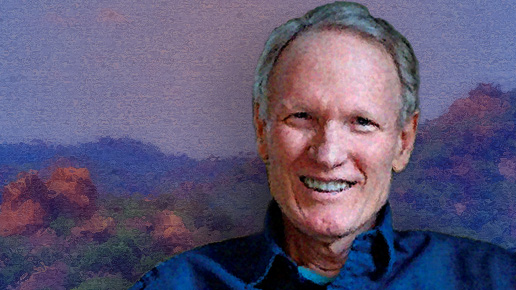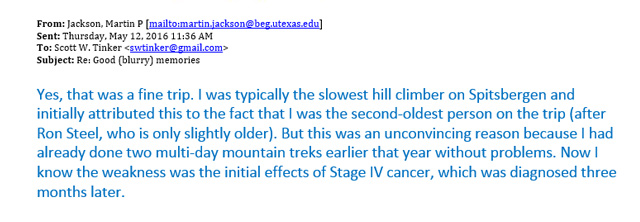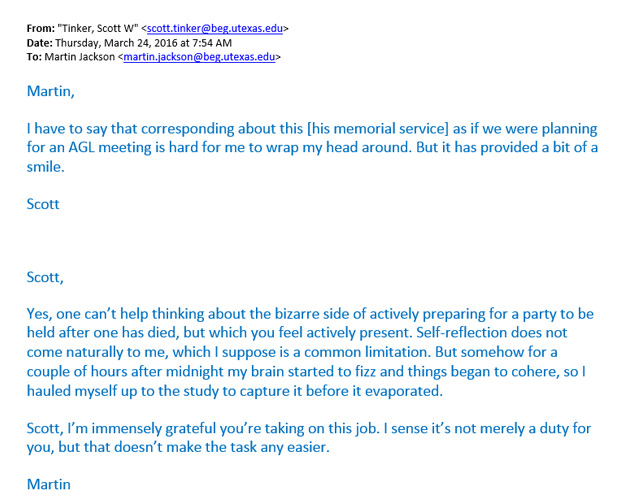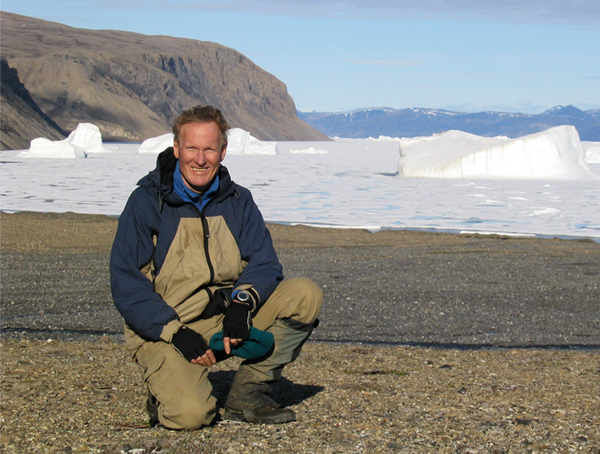In remembrance of Martin P.A. Jackson: a eulogy

On June 23, 2016, the close family and many friends of Martin Jackson gathered in a tribute to, and celebration of, his life. The long-time Bureau scientist passed away on May 31 after a lengthy battle with cancer. The recounting of his life by those close to him sketched a memorable portrait. Martin Jackson lived a remarkable life of discovery and excellence, and frequently left a deep and lasting impression on the lives of those he met.
Among the remembrances of that afternoon is the eulogy presented by Bureau Director Scott W. Tinker. It is reprinted here in its entirety by the kind permission of the Jackson family.
In the fall of 1999, the phone rang in my Marathon Research Lab office in Littleton, Colorado. One of the most genuine voices I had ever heard was on the other end of the line. Not just genuine because of the British–South African accent, but genuine in human quality and richness of content. The voice belonged to Martin Jackson, who was calling to help recruit me to the Bureau of Economic Geology. That conversation removed any doubt that I might have had about joining the Bureau.
Fourteen years later, in August of 2013, Martin and I were sitting together, looking out of the large window of our expedition ship cruising slowly past a spectacular, continuous rock wall of Paleozoic exposures in Svalbard, Norway. We were guests of Statoil on a week-long field trip with 50 students and 20 colleagues from the Jackson School of Geosciences. The light was perfect, the sun low in the sky. Of course, in August, at N79 latitude, the sun is low in the sky 24/7! Martin and I were friends, sharing ideas about what we were seeing geologically. What that meant in practice is that mostly I listened, and tried to soak it up, and Martin humored my occasional contribution.
I knew at the time that was a special moment. Martin and I corresponded about it in May of this year. He wrote to me:

Since the cancer diagnosis, Martin and I have corresponded routinely—both in visits to the Jackson home and via email. It is during these visits with Martin and Jo that I learned that all of Martin’s real friends called him “Marty”!
Some of what I share, at “Marty’s” request, comes from our correspondence, including this email exchange from March 12 of this year:

As always, Martin was correct on many fronts. First, self-reflection for people like Martin, who spend their days looking forward, is not natural. Second, this is not a duty for me, it is a privilege. And third, it is not easy, but relative to a prolonged battle with cancer, the meaning of “easy” is recalibrated. In fact, my correspondence with Martin has been one of the great blessings of my life.
It’s reasonable to say that Martin Jackson had a successful career in geologic research. When he [Martin] arrived in Texas 36 years ago, Bill Fisher, then director of the Bureau of Economic Geology, asked Martin to study rock salt and salt tectonics. For a “hard rock” guy, switching to the softest of rocks was, on the face of it, quite a leap.
Back then the subject of salt was almost completely dead as a research topic. One could look at that in many ways. Martin’s way was to take something dead and to bring it alive! And, of course, one did not say no to Director Fisher.
The peculiar properties of salt cause it, and other rocks around it, to behave in weird and wonderful ways. Martin developed a passion for salt, and during his career amassed more major prizes from international geologic societies and was cited in more scientific papers and books than any other person in the field.
Martin found this success surprising—according to him, even shocking—given that he felt he had, and I quote, “no remarkable intellect and perhaps rather above-average writing ability.” Would it were we could all be saddled with “no remarkable intellect” and “rather above-average writing ability”! I asked Martin if he could pinpoint his success. Three traits seemed important to him.
First, any topic had to be intrinsically interesting for him to fully engage. It did not matter whether the topic was pure science, which has no immediate benefit to society, or was applied science, which has an obvious application to society, such as finding hydrocarbons, metals, or safe sites to store nuclear wastes. All that mattered to him was a fascinating new problem that he could sink his teeth into.
Second, he preferred working on problems scattered across the world rather than just in Texas. Perhaps this reflected his international background, but mostly it was because he preferred to work on frontier areas in which not much was known, even if this ran the risk of getting the story wrong through insufficient data. The big attraction was new, unstudied opportunities providing a sense of exploration.
Finally, he loved working with research colleagues, teaming with congenial companions who, at least according to Martin, had “more skills or more experience.” From my perspective, more skills and more experience would seem to limit the field to a precious few, but Martin felt that his role was to supply the salt-tectonics expertise and fit it into the bigger picture. Some of these international colleagues became his lifelong friends, whether in the field or [in the] laboratory.
Let me share an example of how one of these studies came to benefit from the three-pronged approach—intrinsically fascinating, way off the beaten track, and working with a diverse team.

Martin saw a single aerial photograph taken in the Great Kavir Desert, an enormous uninhabited salt desert in Central Iran. The image showed a blob-shaped salt dome that had risen to the surface and was exposed in more detail than he had ever seen before. He started a project to see if there were any more of the strange salt domes. He spent an entire year tracking down about 100 aerial photos, working his way through government bureaucracies because there were no diplomatic relations with Iran. Using the aerial photos, he and his German assistant mapped the area and discovered a very strange picture: Salt domes had clustered together like a giant bunch of grapes, which had never been reported before—anywhere.
To understand how such a cluster could evolve, Martin spent two months in a Swedish experimental laboratory making models in a centrifuge. He also collaborated with a British mathematical modeler to dig deeper into the mechanical process. Martin roped two eminent Swiss field geologists onto the team who had been on the ground in Central Iran for other purposes, and took advantage of his own dual passport to do field work in Iran. The study discovered a new class of salt structure, which they called a salt canopy, along with insights on how canopies formed and even what lay below them.
So what? you might ask. What relevance was this finding in a part of the world where Yanks can’t even visit? Turning his attention to the Gulf of Mexico, it became evident [to Martin] that the vast proportion of shallowly buried salt there had been misinterpreted, and was, in fact, an enormous series of salt canopies, which were thousands of times larger than the one in Iran. This meant that in the Gulf of Mexico there were whole new worlds to explore below the canopies for oil and gas. So, an intriguing puzzle of pure science in a little-known basin began to yield unimaginable benefits of applied science to society.
For 36 years Martin made his professional home at the Bureau of Economic Geology, serving under three directors and one interim director. For someone who had previously changed jobs in Africa every four years, I asked Martin why he chose to stay so long at the Bureau. After all, there were a myriad of other opportunities. Martin said there were two primary reasons.
First, he felt the way the Bureau operated was ideal. Although he led the raising of external funds for all his projects, he was given almost complete freedom to use those funds sensibly for any research direction. He was also given full support of equipment and facilities. In other words, he had the freedom and independence to build a world-class team of researchers, including students, in salt tectonics. Martin did this in part by establishing a research consortium in 1988 called the Applied Geodynamics Laboratory, or AGL.
Along with the RCRL [Reservoir Characterization Research Laboratory], AGL was the first Industrial Associates program established at the Bureau, and one of the first in geosciences nationally. AGL has been running continuously since 1988 and is still supported by 30 companies. Mike Hudec, a close friend and colleague of Martin’s, serves as principal investigator of the AGL today. Last year, over 300 people from around the globe attended the annual meeting of AGL at the Bureau. It is the leading salt conference in the world.
The second big reason for staying was that Martin regarded the Bureau as a home in the broadest sense. Martin and Jo found the strong outpouring of love and support when he was diagnosed with cancer unbelievable. According to Martin, and again I quote, “it was a revelation to see my colleagues really care about one other; they are not just showing up for a paycheck.”
I hope this has provided some insight into why Martin flourished in science, and why, according to him, he was “happily astonished to be paid so generously for doing something he was passionate about.”
I am in my 17th year as Director of the Bureau. Contrary to how wonderful this role might appear, it is mostly a lonely one. Several months ago, out of great respect for Martin and his perspectives, I asked if he would evaluate me, critically. It was a selfish request, to be sure, but Martin understood my motivation immediately. We both want the best for an organization that we love. I am indebted to Martin for taking on this task.
When Martin passed, I spoke with and received many notes from colleagues and friends. I am sure Mike Hudec received many more, and the family, more still. The response was consistent and clear:
A good man. A great man. A kind man. One of the smartest people I have known. One of the more modest people I have worked with. A mentor to me in time of need. A patient teacher. I learned more from him in a year than [in] the rest of my career.
You get the picture.
The professional community of global geoscientists is improved immeasurably because of Dr. Martin P. A. Jackson. He is most surely one of the finest the Bureau has ever produced: both as a scientist and as a man.
Jo, Britt, and Kirsty; Brian and Andrew; and all of the Jackson family, today we celebrate Marty’s life—by all measures, a life extremely well lived.
Thank you for sharing him with us.

Scott W. Tinker
Director, Bureau of Economic Geology
June 23, 2016